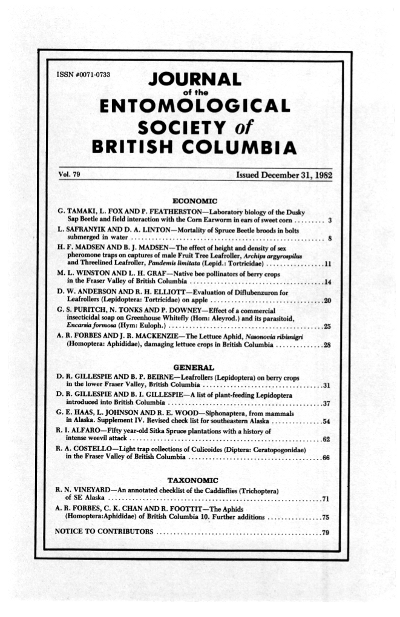Effect of a commercial insecticidal soap on greenhouse whitefly (Hom: Aleyrod.) and its parasitoid, <i>Encarsia formosa</i> (Hym: Euloph.)
Keywords:
whitefly, <i>Encarsia formosa</i>, Hymenoptera, Eulophidae,Abstract
Safer’s Insecticidal Soap (IS) was topically applied at six concentrations to all growth stages of greenhouse whitefly as well as larvae and adults of the whitefly parasitoid, the eulophid wasp <i>Encarsia formosa</i>. IS at 0.5% ai caused more than 94% mortality of all whitefly larval stages and adults, and more than 82.5% mortalitv of whitefly pupae. Adults hatched from treated pupae occasionally showed altered development. E. formosa adults were more tolerant to IS than whitefly and 81.5% survived a 0.5% IS treatment. It was concluded that IS is an effective pesticide for greenhouse whitefly and should be integrated with E. formosa in greenhouse trials.References
Abbott, W.S. 1925. A method of computing the effectiveness of an insecticide. J. Econ. Ent. 18:265-267.
French, N., F.A.B. Ludlam, and L.R. Wardlow. 1973. Observations on the effects of insecticides on glasshouse whitefly [Trialeurodes vaporariorum (Westw.)] Plant Path. 22:99-107.
Harbaugh, B.K. and R.H. Mattson, 1976. Insecticide effects in Encarsia formosa Gahan, parasite of the greenhouse whitefly, Trialeurodes vaporariorum (Westwood). J. Amer. Soc. Hort. Sci. 101: 298-233.
Harris, K.M. 1974. Notes from Wisley: Glasshouse whitefly. J. Royal Hort. Soc. 99:158-162.
Puritch, G.S. 1978. The biocidal effects of fatty acids on various forest pests. Symposium on the pharmacological effects of lipids. AOCS Monograph No. 5:105-112.
Puritch, G.S., P.C. Nigam, and J.R. Carrow. 1980. Chemical control of balsam woolly aphid (Homoptera: Adelgidae) on seedlings of Abies amabilis. J. Entomol. Soc. Brit. Columbia. 77:15-18.
Downloads
Published
Issue
Section
License
Authors who publish with the Journal of the Entomological Society of British Columbia agree to the following terms:
-Authors retain copyright and grant the journal right of first publication with the work simultaneously licensed under a Creative Commons Attribution License that allows others to share the work with an acknowledgement of the work's authorship and initial publication in this journal.
-Authors are able to enter into separate, additional contractual arrangements for the non-exclusive distribution of the journal's published version of the work (e.g., post it to an institutional repository or publish it in a book), with an acknowledgement of its initial publication in this journal.
-Authors are permitted and encouraged to post their work online (e.g., in institutional repositories or on their website) prior to and during the submission process, as it can lead to productive exchanges, as well as earlier and greater citation of published work (See The Effect of Open Access).


